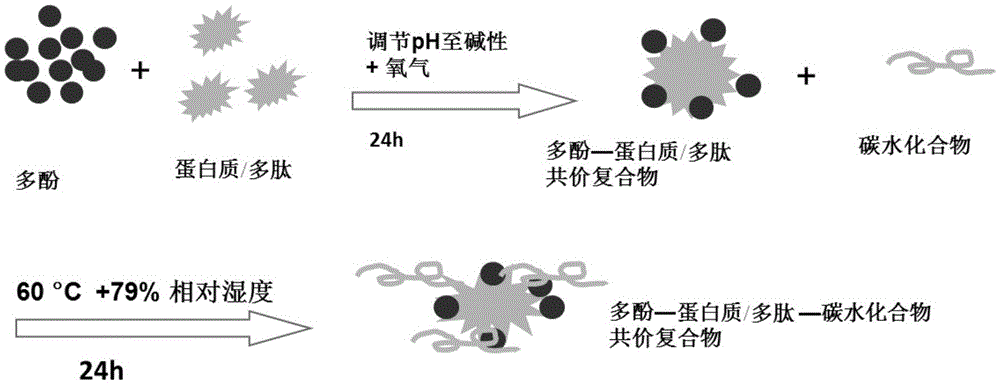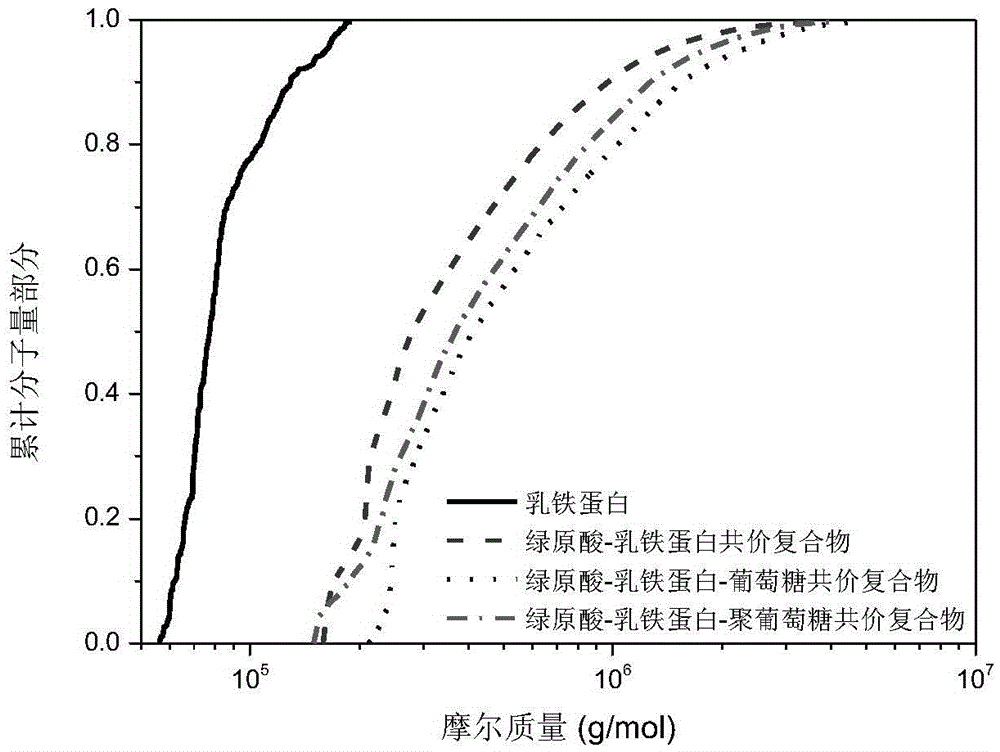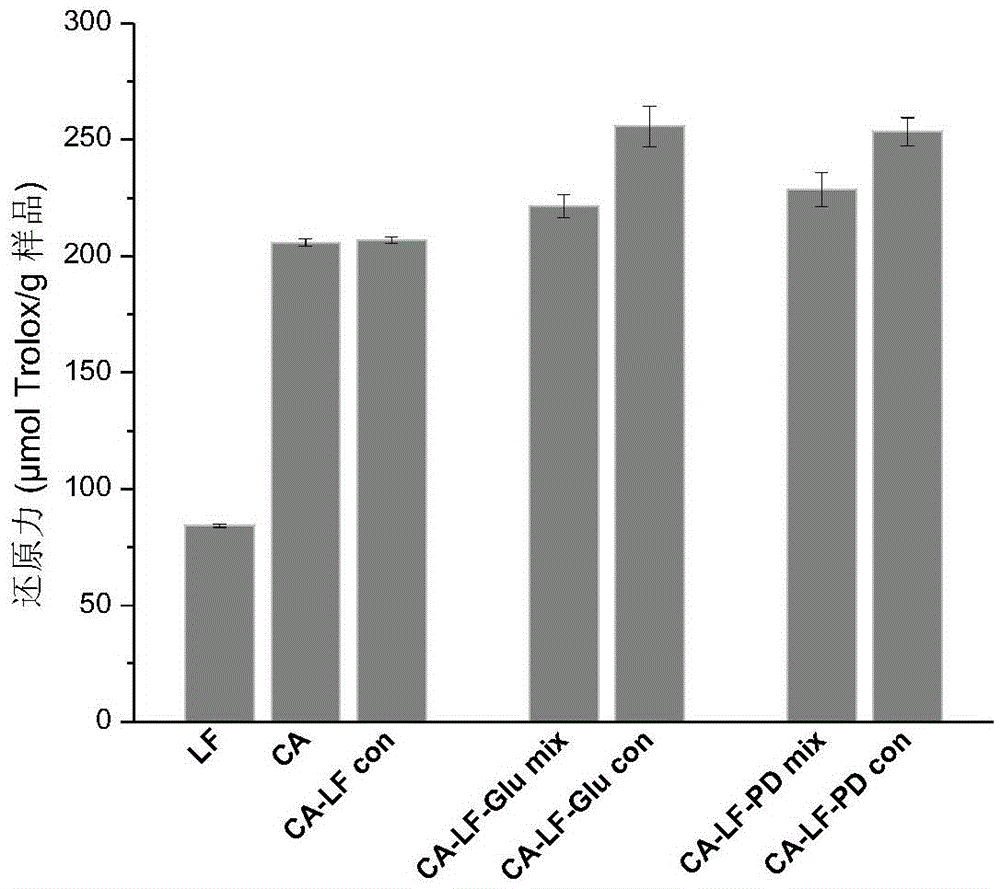Preparation method and application of polyphenol-protein/polypeptide-carbohydrate covalent complexes
A technology of carbohydrates and polyphenolic compounds, applied in the directions of protein-containing food ingredients, applications, food science, etc., can solve the problems that have not yet been seen, and achieve the effects of simple preparation method, easy production, and good physical and chemical stability.
- Summary
- Abstract
- Description
- Claims
- Application Information
AI Technical Summary
Problems solved by technology
Method used
Image
Examples
Embodiment 1
[0030] Example 1: Preparation of Epigallocatechin Gallate (EGCG)-α-Lactalbumin-Glucose Covalent Complex
[0031] Dissolve EGCG (4g / L) and α-lactalbumin (16g / L) in pH 8.0 phosphate buffer to form EGCG solution and α-lactalbumin solution; Mix with α-lactalbumin solution in equal volume to form a mixed solution, and adjust the pH value of the mixed solution to 8.0; then slowly feed oxygen (1 ml / min) into the reaction vessel, react for 24-48h, and keep stirring during the reaction, EGCG is oxidized into quinone compounds and reacts with the side chain amino acid groups of α-lactalbumin to generate EGCG-α-lactalbumin covalent complex; the mixed solution after the reaction is placed in a dialysis bag (molecular weight cut-off 3500kDa), and then Fix the dialysis bag in a dialysis container filled with deionized water, perform dialysis for 24 hours at an ultrasonic frequency of 50KHz, and change the deionized water every 3 hours to ensure that the unreacted free EGCG is completely dia...
Embodiment 2
[0033] Example 2: Preparation of epigallocatechin gallate (EGCG)-whey protein peptide-glucose covalent complex
[0034] Dissolve EGCG (4g / L) and whey protein peptide (16g / L) in phosphate buffer solution of pH 8.0 to form EGCG solution and whey protein peptide solution; Mix with equal volumes of whey protein peptide solution to form a mixed solution, and adjust the pH value of the mixed solution to 8.0; then slowly feed oxygen (1 ml / min) into the reaction vessel, react for 48h, and keep stirring during the reaction process to make the EGCG Oxidize to quinone compounds and react with the side chain amino acid groups of whey protein peptides to generate EGCG-whey protein peptide covalent complexes; place the reacted mixed solution in a dialysis bag (molecular weight cut-off 3500kDa), and then dialyze The bag is fixed in a dialysis container filled with deionized water, and is dialyzed for 24 hours at an ultrasonic frequency of 50KHz, and the deionized water is changed every 3 hou...
Embodiment 3
[0036] Example 3: Preparation of Chlorogenic Acid-Lactoferrin-Glucose Covalent Complex and Chlorogenic Acid-Lactoferrin-Polydextrose Covalent Complex
[0037] Dissolve chlorogenic acid (2g / L) and lactoferrin (10g / L) in phosphate buffer at pH 9.0 to form a chlorogenic acid solution and a lactoferrin solution; The solution is mixed with the lactoferrin solution in equal volumes to form a mixed solution, and the pH value of the mixed solution is adjusted to 9.0; then slowly feed oxygen (1 ml / min) into the reaction vessel for 36 hours of reaction, and the reaction process is constantly stirred to make the chloroform The acid is oxidized to quinone compounds and reacts with the side chain amino acid groups of the protein to form a covalent complex of chlorogenic acid-lactoferrin; the mixed solution after the reaction is placed in a dialysis bag (molecular weight cut-off 3500kDa), and then the dialysis bag Fix it in a dialysis container filled with deionized water, dialyze for 36 ho...
PUM
 Login to View More
Login to View More Abstract
Description
Claims
Application Information
 Login to View More
Login to View More - R&D
- Intellectual Property
- Life Sciences
- Materials
- Tech Scout
- Unparalleled Data Quality
- Higher Quality Content
- 60% Fewer Hallucinations
Browse by: Latest US Patents, China's latest patents, Technical Efficacy Thesaurus, Application Domain, Technology Topic, Popular Technical Reports.
© 2025 PatSnap. All rights reserved.Legal|Privacy policy|Modern Slavery Act Transparency Statement|Sitemap|About US| Contact US: help@patsnap.com



